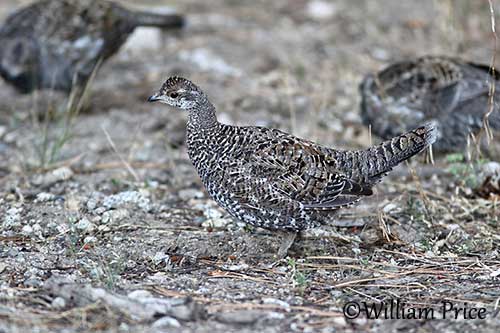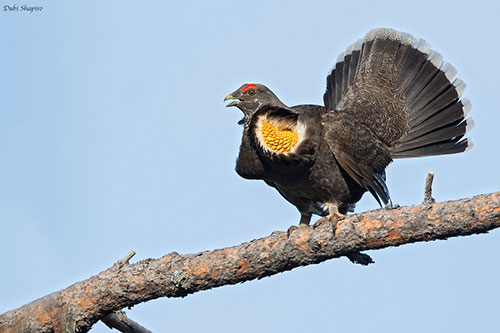
PROTECTION / THREATS / STATUS:
The Sooty Grouse has large range in which it is described as “still common”.
This species is heavily hunted outside protected areas. Habitat loss caused by expansion of agriculture and urbanization affect the populations. Logging at higher elevations may also have a negative impact on winter range.
The size of the population is unknown, but a small decline is suspected.
However, the Sooty Grouse is not globally threatened and currently evaluated as Least Concern.
Fr: Tétras fuligineux
Ang: Sooty Grouse
All: Küstengebirgshuhn
Esp: Gallo Fuliginoso
Ita: Pernice fuligginosa
Nd: Grauw Sneeuwhoen
Sd: sotjärpe
Photographers:
William Price
PBase-tereksandpiper & Flickr William Price
Dubi Shapiro
Dubi Shapiro Photo Galleries
Text by Nicole Bouglouan
Sources:
HANDBOOK OF THE BIRDS OF THE WORLD Vol 2 by Josep del Hoyo-Andrew Elliot-Jordi Sargatal - Lynx Edicions - ISBN: 8487334156
Hennache, A. & Ottaviani, M. (2005). Monographie des faisans, volume 1. Edition W.P.A. France, Clères, France. ISBN: 2-9512467-1-4
Hennache, A. & Ottaviani, M. (2006). Monographie des faisans, volume 2. Edition W.P.A. France, Clères, France.ISBN: 2-9512467-2-2
Les auteurs renoncent à leurs droits d'auteurs pour que la vente de cet ouvrage, publié par la World Pheasant Association, soit destinée à soutenir des projets de conservation.
FIELD GUIDE TO THE BIRDS OF NORTH AMERICA - National Geographic Society - ISBN: 0792274512
Bird Web (Seattle Audubon Society)
South Dakota Birds and Birding – (Terry L. Sohl)
Alaska department of Fish and Game
Atlas of the breeding birds of British Columbia
Splitting the Blue Grouse into the Sooty and Dusky Grouse
What Bird-The ultimate Bird Guide (Mitchell Waite)
Wikipedia, the free encyclopaedia
Sooty Grouse
Dendragapus fuliginosus
Galliformes Order – Tetraonidae Family
INTRODUCTION:
The Sooty Grouse and the Dusky grouse are both members of the genus Dendragapus. They were formerly subspecies of the Blue Grouse and they are now full species.
The Dusky Grouse is mainly found in the interior western US and Canada, whereas the Sooty Grouse occurs along the coast from S Alaska S to N California.
The Sooty Grouse frequents coniferous forests in mountainous areas at high elevation, but it breeds in forests at sea-level in the northern range, and mainly in open forests. During summer, it feeds primarily on leaves, flowers, buds, berries and conifer needles, and also takes insects. During winter, the diet includes conifer needles, leaves and insects. It forages on the ground or in trees, according to the season.
During the breeding season, the male performs courtship displays and struts, while exposing the bright-coloured patches of the neck sides. Displays are accompanied by deep and booming sounds. The female alone performs the nesting duties.
The Sooty Grouse is described as “still common” in most of the range. However, this species is a popular game bird and is heavily hunted outside protected areas. It is also affected by logging at high elevations.
But currently, the Sooty Grouse is not globally threatened.
DESCRIPTION OF THE BIRD:
Biometrics:
Length: M: 46-53 cm – F: 44-48 cm
Weight: M: 1117-1245 g – F: 829-890 g
The Sooty Grouse adult male has dark grey to slate-coloured plumage, with brown and black feathers. On the upperwing, the flight-feathers are mostly brown. The dark grey tail can be fanned into a semicircle. We can see a pale grey terminal band.
On the underparts, the dark feathers have pale fringes, but in worn plumage, the bird appears all dark below.
Back and breast are scaled or scalloped.

The yellow air-sacs are surrounded by white feathers. During the displays, these air-sacs become brighter-yellow and the yellow, bare eye comb becomes orange to bright red.
The bill is greyish-black. The eyes are brown to hazel-brown. The strong legs are feathered. Both legs and feet are grey. The claws are black.
The female is smaller and grey-brown. Crown, nape, scapulars, breast and flanks are barred dark brown. Face and chin are whitish.
The bill is black. The eyes are dark brown. The feathered legs are whitish and the feet are grey.
The juvenile resembles adult female. The upperparts show whitish shaft-streaks, including on wings and tail. The narrow, pointed rectrices are brown.
From north to south of the range, the plumage becomes paler and the tail is longer with more graduated shape.
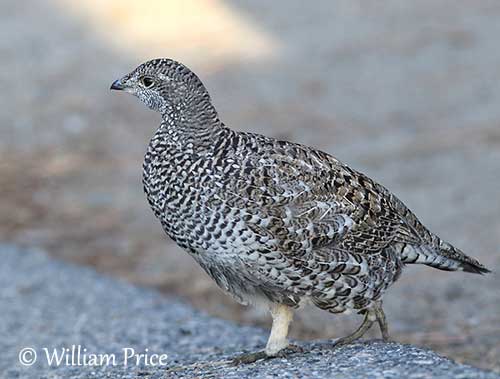
SUBSPECIES AND RANGE:
The Sooty Grouse has 4 subspecies.
D.f. sitkensis is found on Alexander Archipelago (SE Alaska), S to Queen Charlotte Islands in British Columbia.
In this race, the male is like nominate but the female is more reddish.
D.f. fuliginosus (described above) is found in coastal mountains from S Yukon and British Columbia, S to NW California.
D.f. sierrae occurs in the inner coastal range of W USA, from C Washington to C California (Sierra Nevada), E to Warner Mts and W Nevada.
This race is similar to nominate but paler overall. The grey, terminal tail band is broader but the tail is shorter. The female’s belly is much paler.
D.f. howardi occurs in California, from S Sierra Nevada to Greenhorn Mts.
This race is similar to “sierrae” but the male is paler and greyish. The vermiculated pattern of the back is heavier. The terminal tail band is broader and the tail is long and more graduated.
HABITAT:
The Sooty Grouse of the coastal range frequents semi-open coniferous forests all the year, both old growths or recently logged, if there are a large amount of grasses and shrubs.
In the mountainous regions, it is found in deciduous and mixed forests in summer, whereas in winter, it frequents mainly coniferous forests.
The inland birds in summer are usually found where the forest meets the open country, but during winter, they are mainly found in dense coniferous forests.
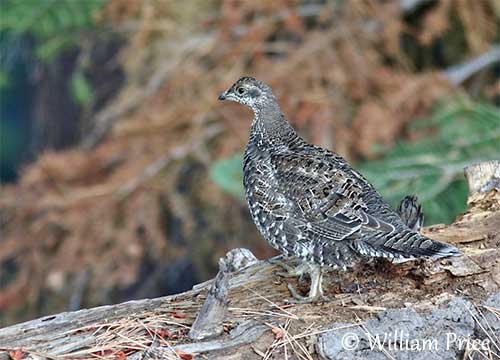
CALLS AND SONGS: SOUNDS BY XENO-CANTO
The Sooty Grouse male gives low-pitched hoot, sometimes given in series, to advertise the territory. This sound is loud and audible to 500 metres or more, depending on weather conditions. This “song” is used to mark the territory, but also to attract females.
The male also utters a growling “gugugug” or “cak-cak-cak” against rivals or intruders, even mammals.
During the displays, if a female is interested by a male, she produces a quavering cackle or whinny. During aggressive behaviour, she gives a hiss or a cluck. When she is separated from her brood, she produces loud, high-pitched “skree, kweer-kweer” calls. The contact between the chicks and their mother is a quiet “tu”.
BEHAVIOUR IN THE WILD:
The Sooty Grouse eats the needles of Douglas-fir, firs and hemlocks, but also buds and twigs during winter. It forages in the early morning and the late afternoon, often perched in middle or upper part of a tree.
It begins to feed on insects, leaves, flowers and berries in the early spring. The young birds feed on numerous insect species pecked from the ground and sometimes gleaned from the vegetation.
The Sooty Grouse also takes tiny stones along road edges, to make the digestion easier.
It forages on the ground in summer but mainly in trees in winter.
Soon after mid-March, the Sooty Grouse starts to display from trees to attract females. The displays include short fluttering flight out from a tree, during which the wingbeats are very noisy. We can hear up to six low-pitched, loud hoots, audible at a distance. The song posts can be more 30 metres high in tree.
The males don’t gather at leks but they may respond to other calling males.

The attracted female produces a soft cackle and the male comes to the ground. It displays and struts around the female. It puffs up the plumage and fans the tail while drooping the wings and bobbing the head. It calls while displaying the yellow air-sacs of the neck sides. Males are probably polygynous.
Against rivals coming too close to the display area, the male adopts threat postures, utter growing calls “gugugug” and chases rivals in flight, engaging sometimes in physical fights.
The male may also become aggressive towards the females and attack them. It does not take part in nesting duties and the female alone performs all the work.
The Sooty Grouse is a short-distance migrant. In autumn, it moves from the open breeding areas to the dense coniferous forests. Most of them move from low breeding areas to montane forests at higher elevations, less frequently the reverse.
In the NW coast, they often breed at sea-level and some of them remain at or near these areas during winter. Others may not migrate. The males leave the breeding grounds before females and young.
The flight of the Sooty Grouse is strong, powerful and direct. During the flight, rapid wingbeats alternate with glides.
REPRODUCTION OF THIS SPECIES:
The laying takes place between late April and June.
The female builds the nest, a shallow scrape lined with dead vegetation (leaves, twigs, moss, bark and needles) and some feathers. It is built under small conifers, stumps or logs.
This species produces a single brood per season, but the female may lay again if the first clutch is lost.
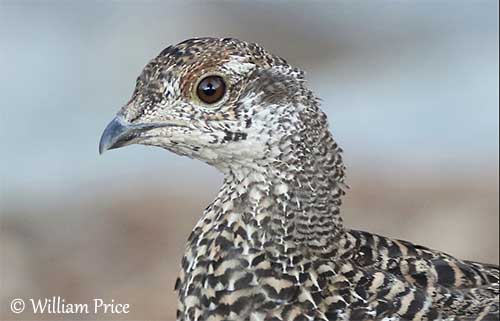
The female lays 6-12 pale buff eggs with brown speckles. She incubates alone during 25-28 days. The downy chicks usually leave the nest within a day after hatching. They are able to follow the female and to find their own food. They have cryptic plumage. The upperparts are yellowish-grey with black and brown mottling.
They young birds can make short flights 8-9 days after hatching. They are fully-grown at about 13 weeks old.
Occasional nest-parasitism by the Ruffed Grouse and the Common Pheasant is sometimes observed.
